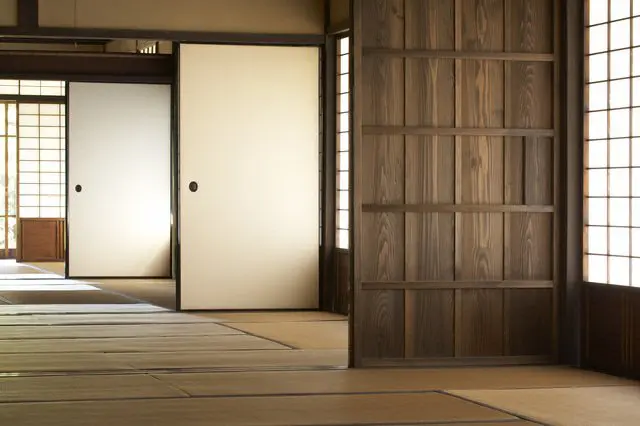Fusuma (Sliding Doors) - Japanese Encyclopedia

Fusuma or sliding doors are used to separate rooms in Japan. In this article, we explain how and where fusuma are used and the various designs of these doors at different popular locations.
Fusuma - Sliding Doors Used To Separate Rooms
In traditional Japanese houses, large spaces are separated for various purposes, depending on the time and occasion. At times large rooms are used for parties and at others, the room is separated and used as smaller private rooms.
In order to create a separation between rooms, sliding doors called fusuma are used. At certain occasions, the fusuma is used as a wall and at others it is used as a door. Not only is it a useful feature of a home, but it is also used as a room decoration. In this article, we would like to explain more about the fusuma.
History of the Fusuma

Prior to the seventh century, Japanese houses did not have structural dividers in rooms and used screens in order to create a separation of the space. However, it was difficult to avoid the cold air during the winter days. That was when a tool with silk covering a wooden frame was invented and became the base of the current fusuma. The ones used specifically in bedrooms were referred to as the fusuma shoji.
After paper was brought to Japan from China, the silk was replaced with paper and the fusuma shoji changed its name to karakami shoji (paper shoji doors). At first, the doors were fit in to divide rooms, but historical scrolls with drawings of that time showed that there were decorative sliding doors that opened and closed by the twelfth century.
On the fusuma, art called Yamato-e ("Japanese images") was drawn. These pictures were mainly motifs of the seasonal views and the people of Japan. The fusuma began appearing in standard households after the twentieth century. By that time, many houses with Western and Japanese-style rooms increased and the fusuma became very convenient to separate the two.
The Structure of the Fusuma and the Various Types

The fusuma is made with multiple layers of Japanese washi paper pasted on a grid-shaped wooden structure. The surface is then finished with a special fusuma paper covering both sides. Fusuma paper can be both paper and fabric with drawings, patterns, various colors, but sometimes it can be simple and plain.
In the case of plain covers, some people write or draw their own images on the fusuma. The edge of the fusuma also varies on the type of wood, paint, color, and thickness as well. The draw handle also is made from various materials and comes in different shapes such as circles, ovals, squares, animal or plant shapes. Depending on the combination, the feeling of the room changes and the fusuma also becomes enjoyable as a room decoration.
Let's Go See Fusuma Art

The sophisticated world of wabi-sabi (Japanese aestheticism with refined simplicity) that spreads across a sheet of paper is a wonderful form of art. Fusuma art is referred to using a specific term in Japanese called shouhekiga and many artists have worked on drawing on the fusuma until this day.
In Kyoto, the fusuma art at the outer palace of the Nijo Castle, Nanzenji Temple, Chishaku-in Temple and Daigoji Temple are very famous.
Places such as Kenninji Temple and Shoren-in Temple have modern art painted on the fusuma, making them into a new and unique tourist spot.
At Toshodaiji Temple in Nara, you will find art on the fusuma drawn by the great Japanese artist of the twentieth century, Kaii Higashiyama. If you happen to venture through temples and castles, why not inspect the art on the fusuma as well?
All pictures from PIXTA
日本への訪日外国人の方が、もっと増えますように!
































![[2026] Top 5 Strawberry Picking Spots in Tokushima, Naruto| Farms and Access Guide for January to May](https://resources.matcha-jp.com/resize/720x2000/2025/03/06-227165.webp)
![[Yamanashi/ Hokuto City] 4 Hot New Spots Opening in 2026](https://resources.matcha-jp.com/resize/720x2000/2025/12/12-252747.webp)


